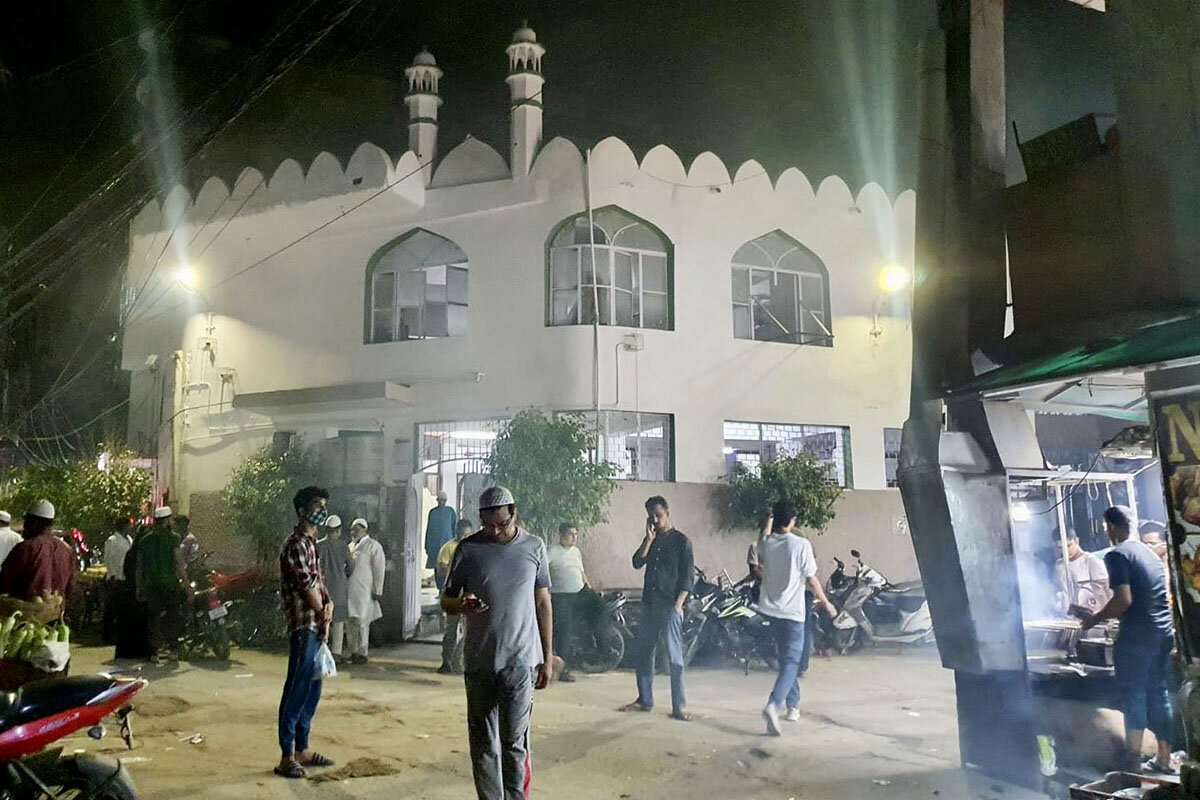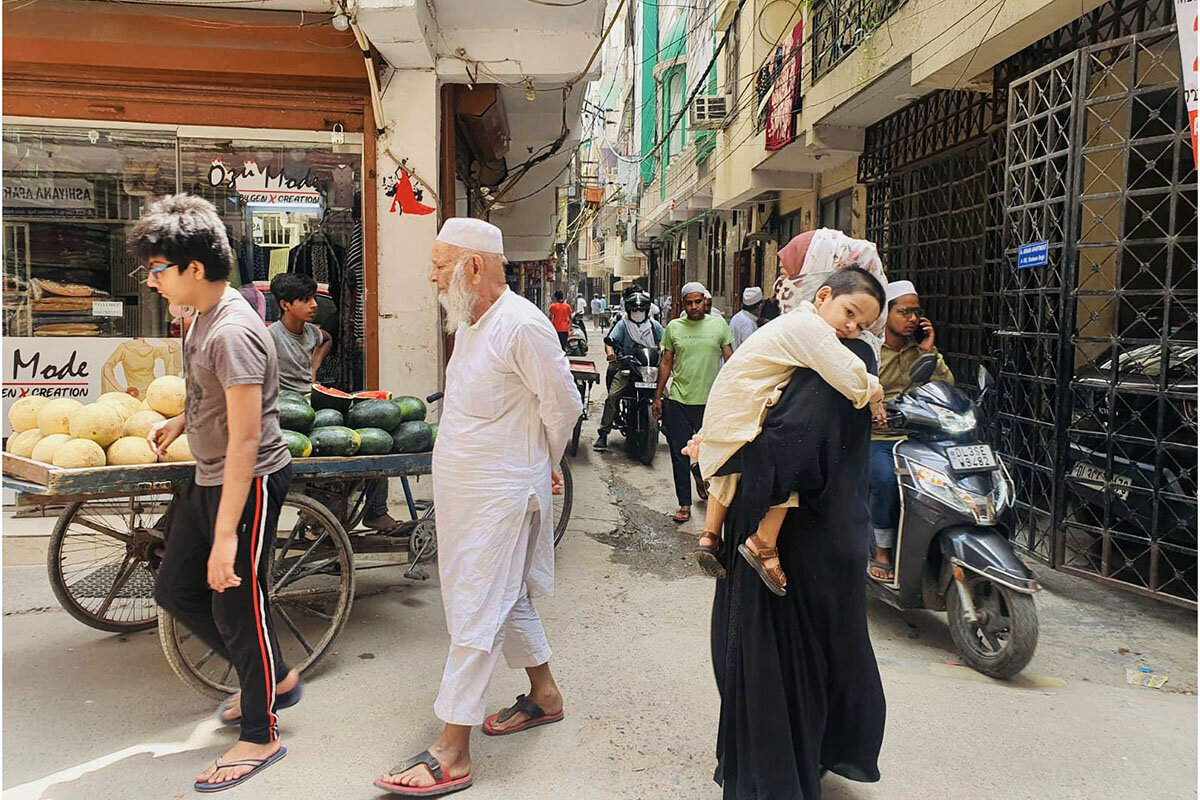Seeking safety: Muslims move to Delhi ‘ghettos’ amid demolition drives
Loading...
| New Delhi
Eight months ago, Imaad Hassan moved out of the posh, Hindu-dominated Sarita Vihar neighborhood in New Delhi to Abul Fazal Enclave – a riverside area that’s long struggled with poor water and electricity access.
“I moved from a gated society to a ghetto for my own safety,” he says. “Every time the news carried events of Hindu-Muslim clashes, my neighbors would stop responding to my greetings. Only Allah knows what would’ve happened had I continued to stay there.”
Reports of hate crimes against religious minorities have spiked since Prime Minister Narendra Modi and the right-wing Bharatiya Janata Party came to power in 2014. At the same time, BJP leaders have advanced new laws and policies that restrict interreligious marriages and Muslim immigration. And in recent months, bulldozers have become a symbol of Hindu nationalist groups as authorities raze Muslim homes, mosques, and shops under the guise of anti-encroachment drives, government campaigns that purport to demolish illegal or unauthorized buildings.
Why We Wrote This
A story focused onFor Indian Muslims, what makes a space safe? Amid escalating violence and recent demolition drives, many are seeking security in Delhi’s majority-Muslim enclaves. But ghettoization comes with risks.
Amid all this, many Delhi residents are leaving mixed-population areas for the city’s Muslim enclaves, which often lack basic amenities and are broadly stigmatized as lawless or unclean. Experts say that Hindutva – an ideology that promotes Hindu hegemony – has become so mainstream that Muslims are forced to choose between expressing their religious identity and their safety.
With regard to Hindutva groups, “their constant messaging [is] that this is our country,” says Nilanjan Mukhopadhyay, a journalist who’s written several books on Indian politics. “Muslims can stay here, but as long as they’re invisible. You don’t offer namaz [prayers] on roads, you don’t wear the hijab, just be invisible.”
The short-term refuge offered by Muslim-majority areas comes at a cost, experts warn, but Mr. Hassan says the trade-offs are worth it. “I don’t have to fear being a Muslim in a ghetto,” he says. “I don’t have to worry about being socially boycotted.”
The rise of Delhi’s ghettos
Delhi’s Muslim enclaves have a long history, with many dating back to Partition or to a 1970s “urban beautification” drive, and they have always carried stigma – though the nature of that stigma has evolved over time, according to Nazima Parveen, independent researcher and author of “Contested Homelands: Politics of Space and Identity.” First, they were seen as zones where the government could contain and protect the Muslim population, then as unhygienic and culturally backward slums, and later as terrorist hideouts.
Although the government isn’t explicitly forcing Muslims to live in these areas today, they’re widely referred to as “ghettos” due to the stigmas and challenges residents face, as well as the pressures Muslims experience to settle there. Landlords in Hindu-majority areas, for example, aren’t always willing to rent to Muslim families.
Dr. Parveen worries that this continued segregation – whether forced or voluntary – will inevitably help Hindu nationalism grow. “Hindus also won’t be willing to live in areas dominated by Muslims, just like Muslims look for areas dominated by their own kind,” she says. “Such developments will have a very dangerous impact on social fabric.”
The ghettoization of Muslims also makes their communities more vulnerable to physical, targeted attacks, as seen in recent demolition drives.
In April, Jahangirpuri resident Mohammed Haseeb witnessed authorities demolish the front gate and wall of a local mosque. A Hindu temple located about 300 feet away was spared. It was one of several recent anti-encroachment drives in the area, which typically follow Muslim-Hindu clashes.
“In ghettos, they come and bulldoze our homes and shops. Outside ghettos, they harass Muslims for simply existing,” he says. “My skullcap, my beard, and even my name attract angry stares.”
Strength in numbers
Rizwan Ansari moved to Shaheen Bagh, a Muslim enclave, in 2018, after living in a Hindu-dominated locality in southwestern Delhi for nine years.
“I don’t dress Islamically, so I could manage somehow, but my wife is a practicing Muslim who wears the hijab. It would be difficult for her to be safe in a Hindu-majority area,” he explains. “Every day there is a new hate crime against Muslims. Every day we learn how much we are being hated in our own country.”
The couple’s life in Shaheen Bagh hasn’t been entirely peaceful, though. As in Jahangirpuri, a bulldozer pulled into a busy Shaheen Bagh street shortly before noon on May 9. But unlike in the April incident, this bulldozer retreated after hundreds of residents and opposition party members surrounded the vehicle and blocked it from its target.
This isn’t the first time the neighborhood became the nerve center of protests against anti-Muslim discrimination. Critics believe the attempted demolition in May was retribution for a series of demonstrations in 2019 and 2020, when Shaheen Bagh residents demanded the withdrawal of the controversial Citizenship Amendment Act, which created a path to citizenship for non-Muslims fleeing neighboring countries.
Mr. Ansari says that despite this chaos, living where Muslims are in the majority brings a sense of security. “Even if anti-Muslim groups attack, we would surely have our own community to stick by us,” he says.
In a nearby neighborhood called Batla House, mechanical engineer Sanaullah Akbar sees ghettos as spaces where Muslims can live without fear, even if these areas lack infrastructure or attract hostility.
And he feels he isn’t alone – Mr. Akbar says that the population in surrounding ghettos seems to have doubled in recent years.
“We will definitely witness new Muslim ghettos coming up,” he says. “I myself would always choose a dilapidated Muslim ghetto rather than living in an affluent, Muslim-minority area.”







